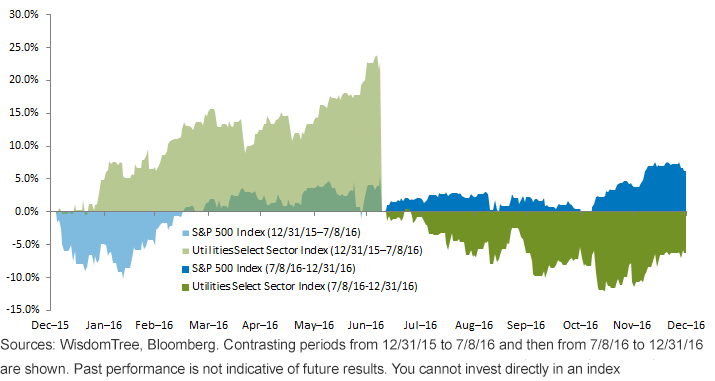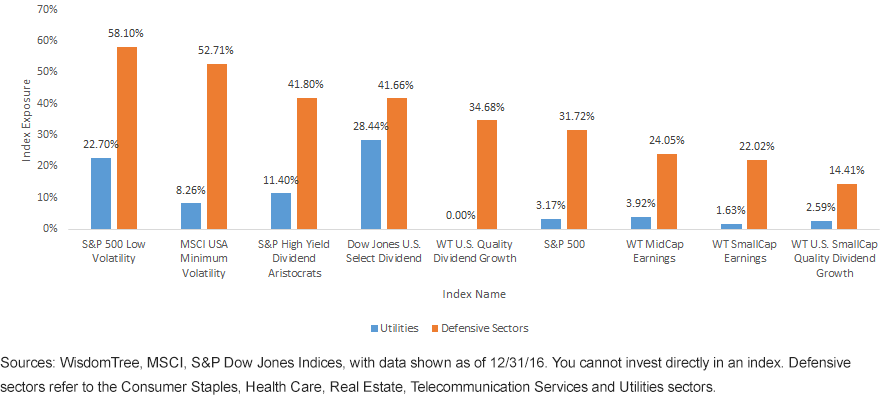Sector Lessons from 2016


If one notes the level of the 10-Year U.S. Treasury yield at the start of 2016 (2.27%) and the end of 2016 (2.44%), it would appear that there wasn’t much change—certainly not a magnitude great enough to warrant expectations of a significant impact on equities.1 However:
• From the start of 2016 to July 8, 2016, the 10-Year Treasury saw a drop in its yield of almost 100 basis points (bps), a major move.
• From July 8, 2016, to the end of the year, the U.S. 10-Year Treasury yield rose more than 100 basis points.
The S&P 500 Index Rose Nearly 12% in 2016
This 12% gain for the S&P 500 was its calendar year return.2 The chart that follows shows how the Utilities sector contributed quite differently to this result during the first-half (falling rate) and second-half (rising rate) environments.
How the Utilities Sector Responded to Falling & Rising Rates in 2016

So What?
Many investors out there may not utilize sector-specific U.S. strategies and may be thinking that our discussion of the Utilities sector is not overly relevant. However, to put things in better context, we note a few strategies that we know people do follow closely, in both the Utilities and overall defensive sector exposures.
Using Sector Exposures to Gauge Rising Rate Sensitivity

• Minimum Volatility & Low Volatility Indexes: What stands out among these strategies is that they each had more than 50% exposure to the defensive sectors. This is impactful in two ways. First, the defensive sectors do tend to have greater inherent sensitivity to rising interest rates, in that the higher-yielding sectors are included here. Second, if rising rates are related to improving economic growth expectations, cyclical sectors could indeed be poised to outperform. In the big picture, we know that investors do follow these types of strategies closely, and it is important to realize that rising rates could be an important friction or resistance to performance.
• Dow Jones U.S. Select Dividend Index: This strategy has tended to hold a large percentage of its exposure in the Utilities sector—nearly 30% as of December 31, 2016. While this positioning would have been tough to beat in the first part of 2016 as the U.S. 10-Year yield dropped by almost 100 basis points, it created a headwind as rates began to rise. Additionally, this strategy played into another important investor demand—along with the S&P High Yield Dividend Aristocrats Index: income. Both of these Indexes have a focus on relatively higher-yielding dividend payers. During the first part of 2016, one of the reasons the Utilities, Real Estate and Telecommunication Services sectors did well was that investors needed income and could not find it in fixed income options. If fixed income interest rates rise, that creates a source of competition for higher-yielding dividend payers, leading to a lower tolerance of equity risk in portions of the portfolio focused on income.
How to Manage Interest Rate Risk with Sector Exposures
As we look to 2017 and beyond, we find ourselves excited by the innovation in how U.S. equity indexes are created to select and weight different types of stocks. Investors who look under the hood have more options than ever before when considering how to manage risk and execute different economic theses. A few particular examples are:
• WisdomTree U.S. Quality Dividend Growth Index: When people see the word “dividend” in an index name, we believe their baseline expectations wouldn’t include a 0% exposure to Utilities. The methodology here avoids firms that 1) tend to borrow money to pay dividends, 2) have slow earnings growth expectations and 3) use higher leverage. The result: no weight to Utilities and the introduction of an interesting tool to consider both growing income as well as managing interest rate risk.
• Earnings Indexes: The true strength of these approaches—and we show the WisdomTree SmallCap Earnings and MidCap Earnings Indexes here—is their management of valuation risk as a direct focus in their methodology. At each year’s annual rebalance, we have seen the price-to-earnings (P/E) multiple drop, due to both elimination of unprofitable companies and weighting profitable firms by the earnings they generate. An interesting corollary is that, for those looking to tilt away from 1) Utilities and 2) defensive sectors, these strategies accomplish an important focus.
• WisdomTree U.S. SmallCap Quality Dividend Growth Index: For investors looking to mitigate interest rate risk in portfolios and thinking from a sector perspective, this Index could be the most interesting option. As of December 31, 2016, there was less than 15% exposure to defensive sectors. Few indexes—especially ones that include only dividend payers—take it to this level, and we think it creates a particularly strong catalyst of interest when being thought of in broader portfolios.
1Sources: WisdomTree, Bloomberg, with data as of 12/31/15 and 12/31/16.
2Sources: WisdomTree, Bloomberg, with data for the period from 12/31/15 to 12/31/16.

Christopher Gannatti began at WisdomTree as a Research Analyst in December 2010, working directly with Jeremy Schwartz, CFA®, Director of Research. In January of 2014, he was promoted to Associate Director of Research where he was responsible to lead different groups of analysts and strategists within the broader Research team at WisdomTree. In February of 2018, Christopher was promoted to Head of Research, Europe, where he was based out of WisdomTree’s London office and was responsible for the full WisdomTree research effort within the European market, as well as supporting the UCITs platform globally. In November 2021, Christopher was promoted to Global Head of Research, now responsible for numerous communications on investment strategy globally, particularly in the thematic equity space. Christopher came to WisdomTree from Lord Abbett, where he worked for four and a half years as a Regional Consultant. He received his MBA in Quantitative Finance, Accounting, and Economics from NYU’s Stern School of Business in 2010, and he received his bachelor’s degree from Colgate University in Economics in 2006. Christopher is a holder of the Chartered Financial Analyst Designation.

